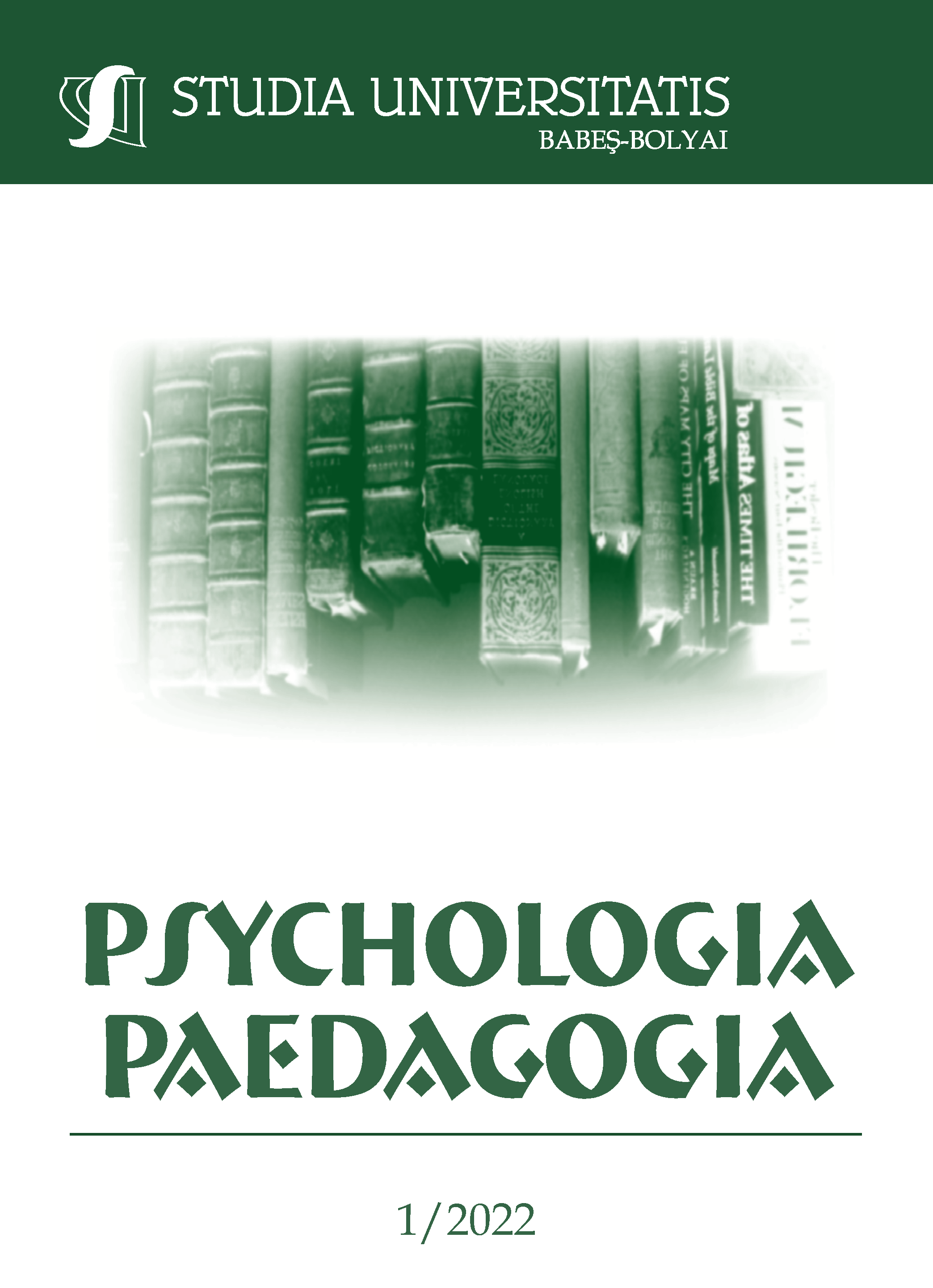VOLUNTEERING IN ROMANIA: A CASE STUDY THAT CAN INFORM GLOBAL VOLUNTEERISM
DOI:
https://doi.org/10.24193/subbpsyped.2022.1.03Keywords:
volunteer, personal development, cultural context, volunteer workAbstract
There are many theories that explain why humans display prosocial behaviors towards their fellows. Such prosocial behaviors manifest differently with respect to the culture where they occur. Over time, some prosocial behaviors have been formalized into volunteer work, which often happens in an association or a non-profit organization. In this qualitative research, we seek to grasp volunteering in its developmental phase, and present how volunteers, volunteers coordinators, and human resources experts conceptualize volunteering. We used a semi-structured interview guide to question 15 volunteers, 10 volunteers’ coordinators, and 10 human resources experts. Findings indicate that volunteering is a learning opportunity, where people can develop their skills while helping others.
Received: 2022 March 05; Revised: 2022 March 25; Accepted: 2022 March 28; Available online: 2022 May 5; Available print: 2022 May 30
References
Ajzen I. (1988) Attitudes, Personality, and Behavior. Dorsey Press, Chicago, IL.
Ajzen, I. (1985). From intentions to actions: A theory of planned behavior. In Action control (pp. 11-39). Springer, Berlin, Heidelberg.
Ajzen, I. (1991). The theory of planned behavior. Organizational behavior and human decision processes, 50(2), 179-211.
Ajzen, I., & Fishbein, M. (1980). Understanding attitudes and predicting social behavior. Englewood Cliffs, NJ: Prentice Hall
Binder, M., & Freytag, A. (2013). Volunteering, subjective well-being and public policy. Journal of Economic Psychology, 34, 97-119.
Borgonovi, F. (2008). Doing well by doing good. The relationship between formal volunteering and self-reported health and happiness. Social science & medicine, 66(11), 2321-2334.
Clary, E. G., Snyder, M., Ridge, R. D., Copeland, J., Stukas, A. A., Haugen, J., et al. (1998). Understanding and assessing the motivations of volunteers: A functional approach. Journal of personality and social psychology, 74(6), 1516.
Conner, M., Sparks, P., Povey, R., James, R., & Shepherd, R. (1996). Attitude-Intention-Behavior links: Moderating role of attitudinal ambivalence. In 11th General Meeting of the European Association of Experimental Social Psychology, Gmunden, Austria.
Curtis, J. E., Grabb, E. G., & Baer, D. E. (1992). Voluntary association membership in fifteen countries: A comparative analysis. American Sociological Review, 139-152.
Dragan, A., & Popa, N. (2017). Social Economy in Post-communist Romania: What Kind of Volunteering for What Type of NGOs?. Journal of Balkan and Near Eastern Studies, 19(3), 330-350.
Eurostat. (2015). Participation in formal or informal voluntary activities or active citizenship by sex, age and educational attainment level. Retrieved from https://appsso.eurostat.ec. europa.eu/nui/submitViewTableAction.do.
Fields, M. (2005). To Educate, Empower or Economize? Lifelong learning in civil society organizations. Research Unit for the Sociology of Education, University of Turku.
Fishbein, M., Ajzen. I. (1975). Belief, attitude, intention and behavior: An introduction to theory and research, 181-202.
Ganesh, S., & Mcallum, K. (2009). Discourses of volunteerism. Annals of the International Communication Association, 33(1), 343–383.
Giles, M., & Cairns, E. (1995). Blood donation and Ajzen's theory of planned behaviour: an examination of perceived behavioural control. British Journal of Social Psychology, 34(2), 173-188.
Grant, S., Maass, S., Vettern, R., Harrington, R., O’Neil, K., McGlaughlin, P., & Good, T. (2020). The impact of volunteering: A multi-state study of 4-H youth development volunteers. Journal of Youth Development, 15(4), 32-50.
Halsall, J., Cook, I., & Wankhade, P. (2016). Global perspectives on volunteerism: Analysing the role of the state, society and social capital. International Journal of Sociology and Social Policy.
Handy, F., Cnaan, R. A., Brudney, J. L., Ascoli, U., Meijs, L. C., & Ranade, S. (2000). Public perception of ‘‘who is a volunteer’’: An examination of the net-cost approach from a cross-cultural perspective. Voluntas: International Journal of Voluntary and Nonprofit Organizations, 11(1), 45–65.
Hazeldine, S., & Baillie Smith, M. (2015). IFRC Global Review of Volunteering Report.
Juknevičius, S., & Savicka, A. (2003). From Restitution to Innovation. In The Values of Volunteering (pp. 127-142). Springer, Boston, MA.
Khasanzyanova, A. (2017). How volunteering helps students to develop soft skills. International Review of Education, 63(3), 363-379.
Kurland, N. B. (1995). Ethical intentions and the theories of reasoned action and planned behavior 1. Journal of applied social psychology, 25(4), 297-313.
Liszt-Rohlf, V., Fields, M., Gerholz, K. H., Seco, V., & Haury, C. (2021). The Benefits of Volunteering, Volunteers' Competencies, and Their Integration into Business Education. International Journal for Business Education, 161, 74-94.
Miles, M. B., Huberman, A. M., & Saldaña, J. (2018). Qualitative data analysis: A methods sourcebook. Sage publications.
Pancer, S. M., & Pratt, M. W. (1999). Social and family determinants of community service involvement in Canadian youth. Roots of civic identity: International perspectives on community service and activism in youth, 32-55.
Penner, L. A. (2002). Dispositional and organizational influences on sustained volunteerism: An interactionist perspective. Journal of Social Issues, 58, 447–467.
Randle, M., & Dolnicar, S. (2009). Does cultural background affect volunteering behavior? Journal of Nonprofit & Public Sector Marketing, 21(2), 225–247
Salamon, L. M., & Sokolowski, S. W. (2003). Institutional roots of volunteering. In The values of volunteering (pp. 71-90). Springer, Boston, MA.
Stukas, A. A., Snyder, M., & Clary, E. G. (2015). Volunteerism and community involvement: Antecedents, experiences, and consequences for the person and the situation.
Voicu, C. I., & Raiu, S. L. (2018). Volunteering Advantages and Difficulties in Romania. Postmodern Openings/Deschideri Postmoderne, 9(4).
Voicu, M., & Voicu, B. (2003). Volunteering in Romania: A Rara Avis. In P. Dekker & L. Halman (Eds.), The values of volunteering: Cross-cultural perspectives (pp. 143–160). Berlin: Springer.
Warburton, J., & Terry, D. J. (2000). Volunteer decision making by older people: A test of a revised theory of planned behavior. Basic and applied social psychology, 22(3), 245-257.
White, K. M., & Greenslade, J. H. (2004). The prediction of above average participation in volunteerism: A test of the theory of planned behaviour and the volunteers functions inventory. In Volunteering Australia 10th National Conference on Volunteering: Volunteering-Evolution, Devolution or Revolution.
Downloads
Published
How to Cite
Issue
Section
License
Copyright (c) 2022 Studia Universitatis Babeș-Bolyai Psychologia-Paedagogia

This work is licensed under a Creative Commons Attribution-NonCommercial-NoDerivatives 4.0 International License.


